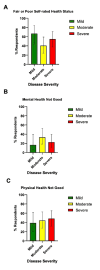This is a preprint.
A Cross-Sectional Study of Health-Related Quality of Life in Patients with Predominantly Antibody Deficiency
- PMID: 39070620
- PMCID: PMC11276022
- DOI: 10.21203/rs.3.rs-4612913/v1
A Cross-Sectional Study of Health-Related Quality of Life in Patients with Predominantly Antibody Deficiency
Update in
-
A Cross-Sectional Study of Health-Related Quality of Life in Patients with Predominantly Antibody Deficiency.J Clin Immunol. 2024 Aug 7;44(8):173. doi: 10.1007/s10875-024-01781-y. J Clin Immunol. 2024. PMID: 39110257 Free PMC article.
Abstract
Health-related quality of life (HRQoL) measures individual well-being across physical, psychological, and social domains. Patients with predominantly antibody deficiency (PAD) are at risk for morbidity and mortality, however, the effect of these complications on HRQoL requires additional study. Patients with PAD were asked to voluntarily complete the Centers for Disease Control (CDC) HRQoL-14 Healthy Days Measure questionnaire. These results were compared to data from the CDC-initiated Behavioral Risk Factor Surveillance System (BRFSS), a cross-sectional questionnaire including questions from CDC-HRQOL-14. Statistical analyses included two-proportion Z-test, t-tests, and analysis of variance. 83 patients with PAD completed the survey. Patients were sub-stratified into mild (23.7%), moderate (35.5%), severe (40.8%), and secondary (8.4%) PAD. "Fair or poor" health status was reported in 52.6% of PAD patients. Mental health challenges ≥ 14 days/month occurred in 25% of patients. Physical health issues ≥ 14 days/month was reported in 44.7% of patients. Activity limitations were noted by 80.3% of patients. There were no statistically significant differences by PAD severity. Patients with autoinflammatory disease co-morbidities reported more mental health challenges compared to those without (78% vs. 54.3%, p = 0.02). Compared to the CDC-BRFSS data, significantly more patients with PAD reported "fair or poor" health status (53% vs 12.0%; p < 0.0001), mental health challenges (24.1% vs 14.7%; p = 0.02), and poor physical health (44.6% vs 8.0%; p < 0.0001). Patients with PAD had significantly reduced HRQoL compared to CDC-BRFSS respondents from a similar geographical region. Decreased HRQoL was prevalent across all PAD severity levels. Additional research is needed to improve HRQoL for patients with PAD.
Keywords: Behavioral risk factor surveillance system; CDC HRQoL-14; Chronic disease management; Common variable immunodeficiency; Health-related quality of life; Hypogammaglobulinemia; Immunodeficiency; Immunoglobulin therapy; Mental health; Patient-reported outcomes; Physical health; Predominantly antibody deficiency.
Conflict of interest statement
Disclosure of Conflicts of Interest: Jocelyn R. Farmer is an ongoing consultant for Pharming and has received investigator-initiated research grants from Pfizer, Bristol Myers Squibb, and Pharming with no direct relation to the work presented. Daniel DiGiacomo has received consulting fees from BASF.
Figures





References
Publication types
Grants and funding
LinkOut - more resources
Full Text Sources

